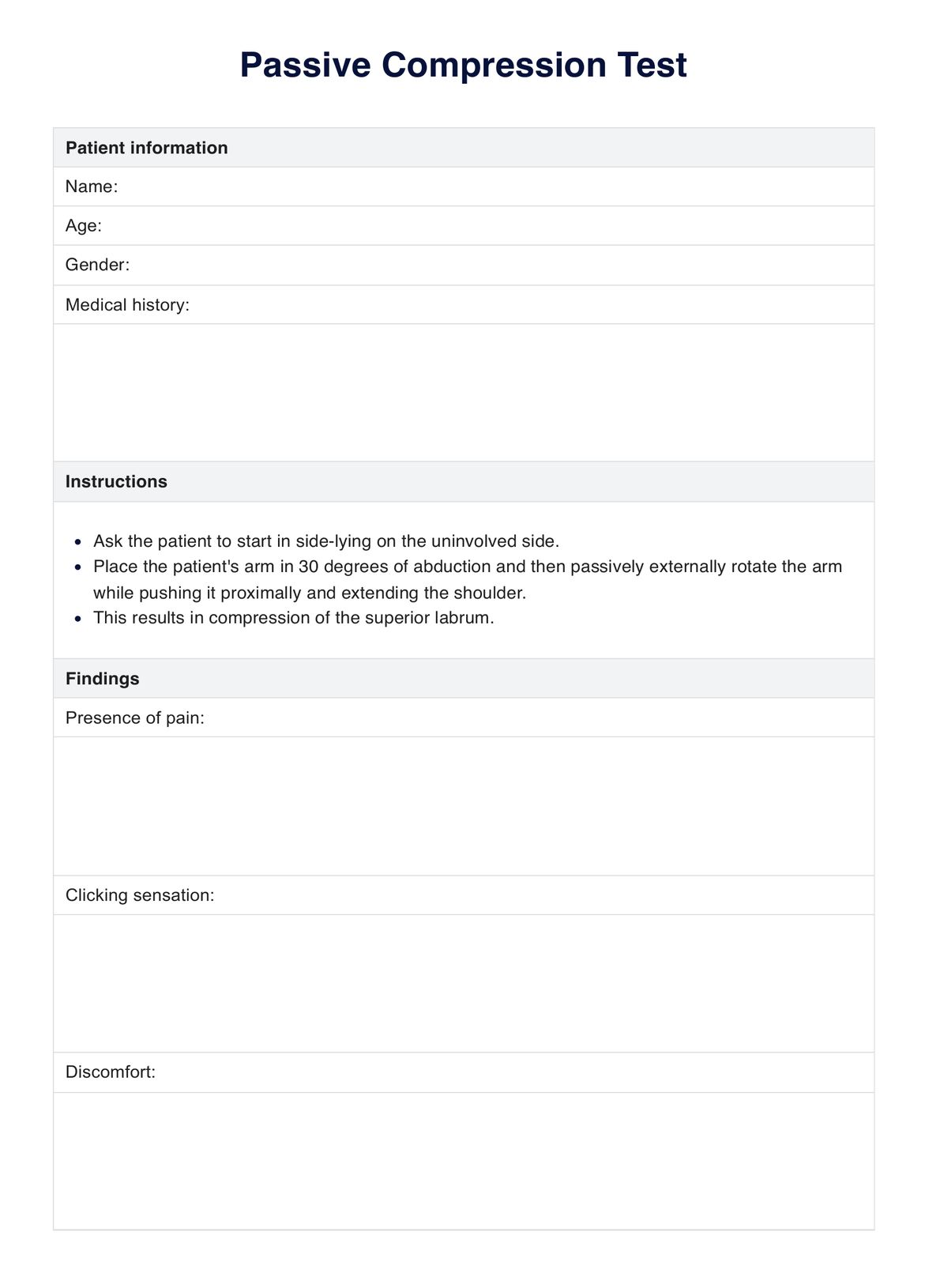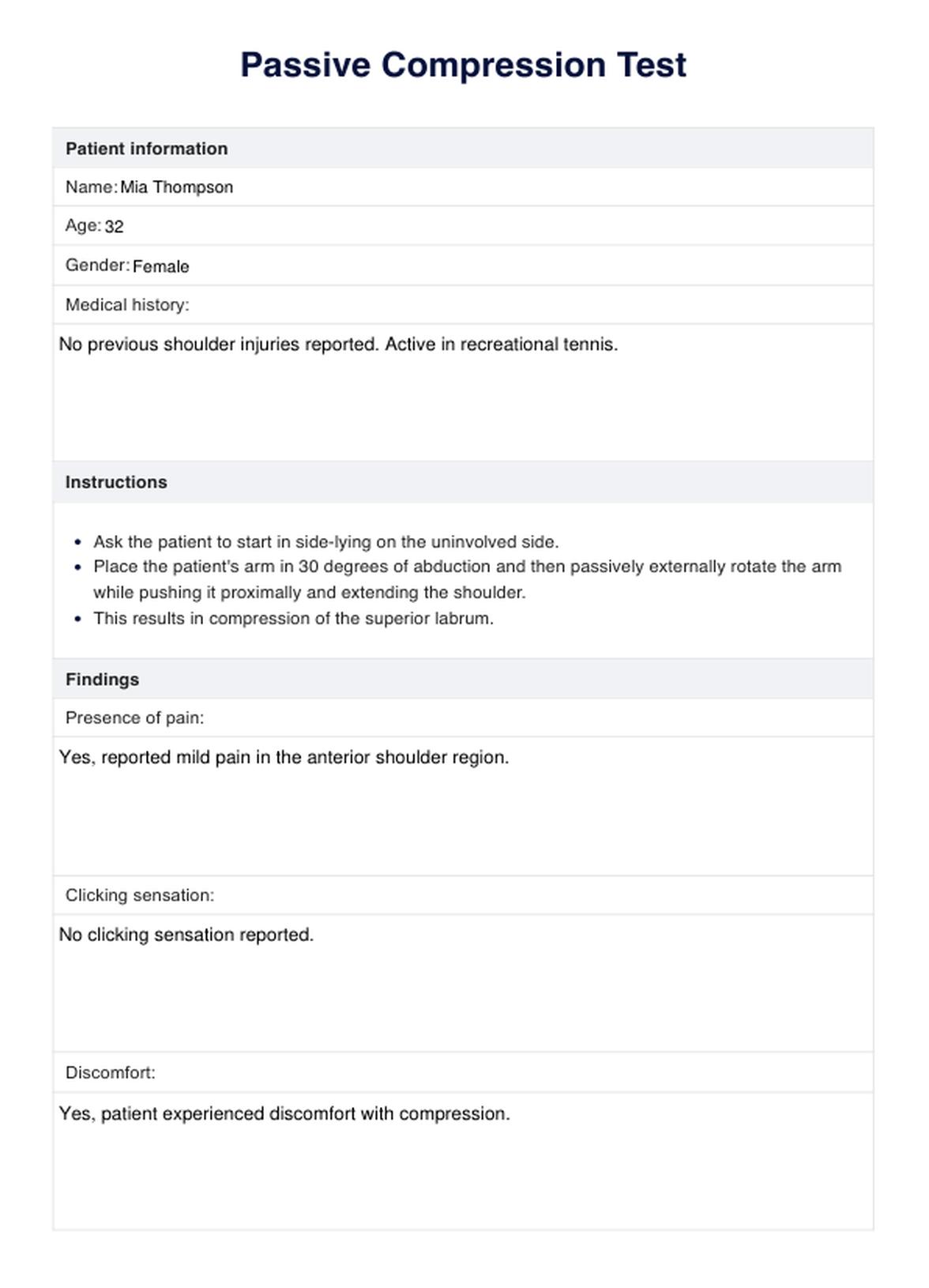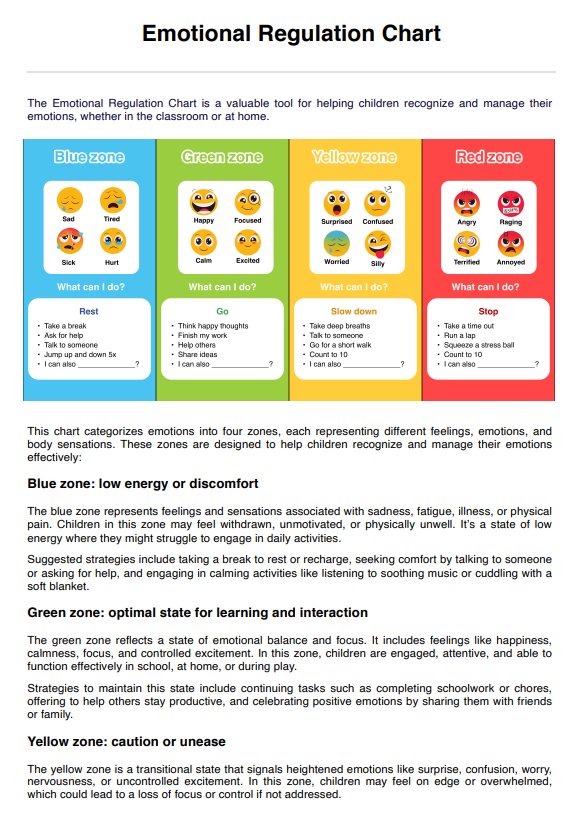Passive Compression Test
Get Carepatron's free PDF download on passive compression test with examples to enhance your understanding. Start learning now!


What are SLAP lesions?
Superior labrum anterior to posterior, (SLAP) lessions are injuries that occur in the superior labrum of the shoulder, particularly where the biceps tendon attaches. These lesions are common among athletes involved in overhead sports such as baseball, tennis, and volleyball, but they can also affect non-athletes due to traumatic events or wear and tear over time.
According to Kim Y.S et. al (2007), despite the availability of various physical tests for superior labrum anterior-posterior lesions, few reports have assessed their accuracy, and none can be considered entirely predictive for diagnosing SLAP lesions in the shoulder joint. However, this innovative clinical test has emerged as a valuable and precise method for identifying SLAP tears in the shoulder joint.
During a SLAP lesion, the superior labrum of the glenohumeral joint becomes damaged, which can lead to pain, weakness, and instability in the shoulder. One distinguishing characteristic of SLAP lesions is disrupting the labrum's attachment to the glenoid socket at the top of the shoulder.
Clinicians often use a new clinical test known as the passive compression test for superior labral tears to diagnose SLAP lesions. During this test, the examiner rotates the patient's arm while applying passive compression to the shoulder joint. If the patient experiences pain or a clicking sensation, it may indicate a SLAP lesion.
Common symptoms of SLAP lesions
SLAP lesions can manifest in various ways, often causing discomfort and functional impairment in the shoulder joint. Recognizing the symptoms is essential for timely diagnosis and treatment. Here are the common signs and symptoms associated with SLAP lesions:
- Shoulder pain, especially with overhead movements
- Clicking, popping, or grinding sensations in the shoulder joint
- Weakness or instability in the shoulder, particularly during activities requiring overhead motion
- Decreased range of motion, especially with external rotation
- Difficulty performing tasks that involve lifting, reaching, or throwing
- Pain or discomfort while sleeping on the affected shoulder
- Persistent discomfort or aching sensation in the shoulder, even at rest
These symptoms may vary in severity and can worsen over time if left untreated. If you experience any of these symptoms, it's important to consult a healthcare professional for proper evaluation and management. Early intervention can help alleviate pain and prevent further damage to the shoulder joint.
Causes of these lesions
SLAP lesions can arise from various factors, including traumatic injuries and repetitive motions that place stress on the shoulder joint. Understanding the underlying causes can help prevent these injuries and promote shoulder health. Here are the common causes of SLAP lesions:
- Traumatic events such as falls, motor vehicle accidents, or direct blows to the shoulder
- Repetitive overhead motions, commonly seen in athletes participating in sports like baseball, tennis, and swimming
- Forceful pulling or lifting movements leading to excessive strain on the shoulder joint
- Degenerative changes associated with aging or wear and tear of the shoulder structures
- Anatomical abnormalities or congenital conditions that predispose individuals to shoulder injuries
- Improper lifting techniques or poor posture increasing the risk of shoulder injuries over time
Individuals can take proactive measures to reduce the risk of developing SLAP lesions and other shoulder injuries by identifying and addressing these contributing factors.
Passive Compression Test Template
Passive Compression Test Example
What is the Passive Compression Test?
The Passive Compression Test is a clinical test used to assess for superior labral tears, particularly in the context of sports medicine and shoulder injuries. During this test, the examiner places the patient's arm in an externally rotated position while applying passive compression to the shoulder joint. This maneuver stresses the glenohumeral joint's superior labrum, where SLAP (Superior Labrum Anterior to Posterior) lesions commonly occur.
In the Passive Compression Test for superior labral, the examiner passively externally rotates the patient's arm to provoke symptoms associated with superior labral tears, such as pain or clicking sensations. Clinicians can elicit specific responses indicative of labral pathology by applying compression to the shoulder joint.
This clinical test for superior labral tears provides valuable diagnostic information, aiding healthcare practitioners in identifying SLAP lesions and guiding appropriate management strategies. The Passive Compression Test serves as a complementary tool alongside other diagnostic modalities, helping to enhance the accuracy of diagnoses and optimize patient care.
How is this test conducted?
Conducting the Passive Compression Test involves a series of straightforward steps designed to evaluate the integrity of the superior labrum and identify potential SLAP lesions. Here's a concise guide on how to perform the test:
- Begin by comfortably placing the patient in a seated or supine position, ensuring access to the affected shoulder.
- Stand behind the patient and gently grasp the affected arm at the wrist, stabilizing the shoulder joint with your other hand.
- Externally rotate the patient's arm passively, bringing it into a position of external rotation while keeping the elbow flexed at 90 degrees.
- With the patient's arm in external rotation, apply passive compression to the shoulder joint by pressing down on the proximal humerus with your stabilizing hand.
- While maintaining the external rotation and compression, observe the patient for any signs of pain, discomfort, or clicking sensations in the shoulder joint.
- Note any positive responses elicited during the clinical test for superior labral, including the location and nature of the patient's symptoms.
How are the results interpreted?
Interpreting the results of the Passive Compression Test involves understanding the significance of both positive and negative findings. Here's a breakdown of how to interpret the test results:
- Positive result: If the patient experiences pain, discomfort, or clicking sensations in the shoulder joint during the Passive Compression Test, it may indicate a positive outcome. This suggests the presence of superior labral pathologies, such as a SLAP lesion or other labral tear.
- Negative result: A negative result occurs when the patient does not experience any significant symptoms or discomfort during the test for superior labral. Such cases suggest the absence of superior labral pathology or other significant shoulder abnormalities. However, it's important to note that a negative result does not entirely rule out the possibility of a SLAP lesion, as some tears may not produce symptoms during the Passive Compression Test.
Understanding the implications of positive and negative results is essential for accurate diagnosis and appropriate management of shoulder injuries.
How to use our Passive Compression Test template
Carepatron's Passive Compression Test template simplifies conducting and documenting the test, streamlining workflow for medical professionals. Here's a step-by-step guide on how to effectively use the template:
Step 1: Access the template
Log in to your Carepatron account and navigate to the Templates section. Search for the Passive Compression Test template or browse the relevant category. Click on the template to access and open it for use.
Step 2: Customize patient information
Input the patient's demographic details, including name, age, gender, and relevant medical history. Ensure patient information accuracy and completeness to facilitate proper documentation and tracking.
Step 3: Perform the clinical test
Follow the instructions provided in the template for conducting the Passive Compression Test. Position the patient, apply external rotation, and administer passive compression as outlined in the template.
Step 4: Record findings
Document the test results accurately within the template's designated fields. Note any symptoms experienced by the patient, including pain, clicking sensations, or discomfort.
Step 5: Interpret results
Interpret the findings of the test based on the presence or absence of symptoms reported by the patient. Use the template's guidelines to determine whether the results are positive or negative for superior labral pathology.
Step 6: Save and share
Save the completed template within your Carepatron account for future reference and tracking. As needed, share the test results and findings with other healthcare professionals involved in the patient's care.
Benefits of conducting this test
The Passive Compression Test offers several advantages for healthcare practitioners in evaluating shoulder pathology. This clinical test enhances diagnostic accuracy and streamlines the evaluation process by providing a non-invasive and efficient means of assessing for superior labral tears.
Here are the advantages of conducting this new clinical test:
Enhanced diagnostic accuracy
The Passive Compression Test provides healthcare practitioners a reliable tool for assessing superior labral tears and identifying potential SLAP lesions. Clinicians can elicit symptoms indicative of labral pathology by applying passive compression to the shoulder joint while rotating the patient's arm externally.
Streamlined evaluation process
Unlike traditional diagnostic methods, such as imaging studies or invasive procedures, the Passive Compression Test offers a non-invasive and efficient means of evaluating shoulder pathology. With clear guidelines and standardized procedures, medical professionals can conduct the test quickly and easily within a clinical setting. This streamlined evaluation process saves time and resources while ensuring a comprehensive assessment of the shoulder joint, particularly in sports med and musculoskeletal injuries.
You can also use the Prescription Template to streamline the process of documenting and managing medication orders. This tool helps ensure accuracy in prescribing, track medication usage, and maintain comprehensive patient records.
Early detection and intervention
Early detection of superior labral tears is crucial for implementing timely interventions and preventing further damage to the shoulder joint. The Passive Compression Test enables healthcare practitioners to identify SLAP lesions in their early stages, allowing for prompt initiation of appropriate treatment strategies.
Improved patient outcomes
The ability to accurately diagnose and effectively manage shoulder injuries enhances the quality of patient care, promoting faster recovery and return to function. Additionally, the noninvasive test reduces patient discomfort and anxiety associated with more invasive diagnostic procedures, contributing to a positive patient experience overall.
Enhanced sports medicine practice
For healthcare practitioners specializing in sports medicine, the Passive Compression Test is a valuable tool for evaluating shoulder injuries commonly encountered in athletes. This targeted approach facilitates the safe and expedited return to sports participation while minimizing the risk of recurrent injuries.
SLAP lesion treatments
SLAP lesions present a spectrum of shoulder injuries, ranging from mild to severe tears in the superior labrum. Effective treatment strategies for SLAP lesions are as follows:
Conservative management
Conservative management is often the initial approach for treating SLAP lesions, particularly in cases of mild to moderate tears. This approach may include rest, activity modification, physical therapy, and anti-inflammatory medications to alleviate pain and inflammation. Physical therapy focuses on strengthening the surrounding shoulder muscles, improving range of motion, and enhancing shoulder stability.
Arthroscopic surgery
For severe or persistent SLAP lesions that do not respond to conservative treatments, arthroscopic surgery may be recommended. Arthroscopic surgery is a minimally invasive procedure performed using small incisions and specialized instruments inserted into the shoulder joint. The torn labrum is repaired or reattached to the glenoid socket during the surgery using sutures or anchors.
Biceps tenodesis
In cases where the biceps tendon is involved in the SLAP lesion or contributes to ongoing symptoms, biceps tenodesis may be considered as part of the treatment plan. Biceps tenodesis involves repositioning or anchoring the biceps tendon to a different location on the humerus, away from the torn labrum.
Rehabilitation and postoperative care
Following surgical intervention for SLAP lesions, rehabilitation plays a crucial role in optimizing recovery and restoring shoulder function. Physical therapy focuses on restoring range of motion, strengthening the shoulder muscles, and improving shoulder stability.
References
Kim, Y.-S., Kim, J.-M., Ha, K.-Y., Choy, S., Joo, M.-W., & Chung, Y.-G. (2007). The Passive Compression Test. The American Journal of Sports Medicine, 35(9), 1489–1494. https://doi.org/10.1177/0363546507301884
Commonly asked questions
Passive compression is a clinical test used to assess for superior labral tears by externally rotating the patient's arm and applying passive compression to the shoulder joint to elicit specific symptoms indicative of labral pathology.
A positive O'Brien's test, also known as the active compression test, suggests a labral tear or other pathology in the shoulder joint, particularly if the pain is felt with resisted forward flexion and internal rotation but not external rotation.
The active compression test, also known as O'Brien's test, is a clinical examination maneuver used to assess for superior labral tears by evaluating pain and weakness during resisted forward flexion and internal rotation of the shoulder joint.






















-template.jpg)
















































































